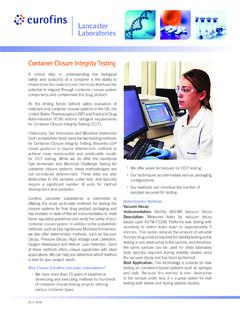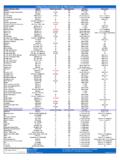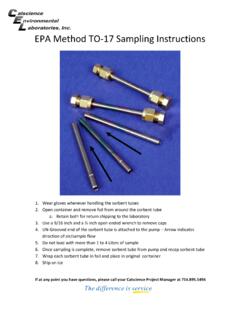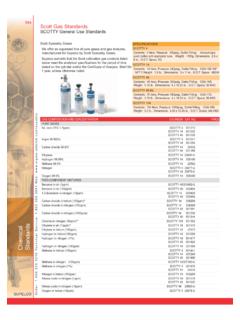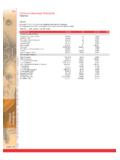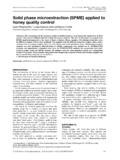Transcription of Compendium of Methods for the Determination of …
1 EPA/625/R-96/010bCompendium of Methodsfor the Determination ofToxic organic Compoundsin Ambient AirSecond EditionCompendium Method TO-13 ADetermination of Polycyclic AromaticHydrocarbons (PAHs) in Ambient Air Using GasChromatography/Mass Spectrometry (GC/MS)Center for Environmental Research InformationOffice of Research and Environmental Protection AgencyCincinnati, OH 45268 January 1999iiMethod TO-13 AAcknowledgementsThis Method was prepared for publication in the Compendium of Methods for the Determination of ToxicOrganic Compounds in Ambient Air, Second Edition (EPA/625/R-96/010b), under Contract No.
2 68-C3-0315,WA No. 3-10, by Midwest Research Institute (MRI), as a subcontractor to Eastern Research Group, Inc. (ERG),and under the sponsorship of the Environmental Protection Agency (EPA). Justice A. Manning, John , and Scott R. Hedges, Center for Environmental Research Information (CERI), and Frank F. McElroy,National Exposure Research Laboratory (NERL), all in the EPA Office of Research and Development (ORD),were responsible for overseeing the preparation of this method. Additional support was provided by othermembers of the Compendia Workgroup, which include: John O.
3 Burckle, EPA, ORD, Cincinnati, OH James L. Cheney, Corps of Engineers, Omaha, NB Michael Davis, EPA, Region 7, KC, KS Joseph B. Elkins Jr., EPA, OAQPS, RTP, NC Robert G. Lewis, EPA, NERL, RTP, NC Justice A. Manning, EPA, ORD, Cincinnati, OH William A. McClenny, EPA, NERL, RTP, NC Frank F. McElroy, EPA, NERL, RTP, NC Heidi Schultz, ERG, Lexington, MA William T. "Jerry" Winberry, Jr., EnviroTech Solutions, Cary, NCMethod TO-13 was originally published in March of 1989 as one of a series of peer-reviewed Methods in thesecond supplement to Compendium of Methods for the Determination of toxic organic Compounds in AmbientAir, EPA 600/4-89-018.
4 In an effort to keep these Methods consistent with current technology, Method TO-13has been revised and updated as Method TO-13A in this Compendium to incorporate new or improved samplingand analytical method is the result of the efforts of many individuals. Gratitude goes to each person involved in thepreparation and review of this (s) William T. "Jerry" Winberry, Jr., EnviroTech Solutions, Cary, NC Greg Jungclaus, Midwest Research Institute, Kansas City, MOPeer Reviewers Nancy Wilson, EPA, NERL, RTP, NC Joan Bursey, ERG, Morrisville, NC Irene D.
5 DeGraff, Supelco, Bellefonte, PA Jane Chuang, Battelle Laboratories, Cincinnati, OH Robert G. Lewis, EPA, NERL, RTP, NC Lauren Drees, EPA, NRMRL, Cincinnati, OHiiiFinally, recognition is given to Frances Beyer, Lynn Kaufman, Debbie Bond, Cathy Whitaker, and Kathy Johnsonof Midwest Research Institute's Administrative Services staff whose dedication and persistence during thedevelopment of this manuscript has enabled its Compendium has been subjected to the Agency's peer and administrative review, and it has beenapproved for publication as an EPA document.
6 Mention of trade names or commercial products doesnot constitute endorsement or recommendation for page intentionally left blankvMETHOD TO-13 ADetermination of Polycyclic Aromatic Hydrocarbons (PAHs) in Ambient Air Using Gas Chromatography/Mass Spectrometry (GC/MS)TABLE OF CONTENTSPage1. Summary of Applicable ASTM EPA Other Limitations and Sample Clean-Up and Sample Equipment and Materials for Sample Sample Clean-up and GC/MS Sample Preparation of PUF Sampling Summary of Preparation of Sampling Procedure for Certification of PUF Cartridge Deployment of Cartridges for Field Assembly, Calibration, and Collection Using Sampling Sampling Calibration of Sampling Sample OF CONTENTS, CONTINUEDP agevi12.
7 Sample Extraction, Concentration, and Sample Soxhlet Extraction and Sample Gas Chromatography with Mass Spectrometry Calibration of GC/ GC/MS Instrument Operating Sample Analysis by Quality Assurance/Quality Control (QA/QC).. General System Process, Field, and Solvent 1999 Compendium of Methods for toxic organic Air PollutantsPage 13A-1 METHOD TO-13 ADetermination of Polycyclic Aromatic Hydrocarbons (PAHs) in Ambient Air Using Gas Chromatography/Mass Spectrometry (GC/MS)1. Polycyclic aromatic hydrocarbons (PAHs) have received increased attention in recent years in air pollutionstudies because some of these compounds are highly carcinogenic or mutagenic.
8 In particular, benzo[a]pyrene(B[a]P) has been identified as being highly carcinogenic. To understand the extent of human exposure to B[a]Pand other PAHs, reliable sampling and analytical Methods are necessary. This document describes a samplingand analysis procedure for common PAHs involving the use of a combination of quartz filter and sorbentcartridge with subsequent analysis by gas chromatography with mass spectrometry (GC/MS) detection. Theanalytical Methods are modifications of EPA Test Method 610 and 625, Methods for organic Chemical Analysisof Municipal and Industrial Wastewater, and Methods 8000, 8270, and 8310, Test Methods for Evaluation ofSolid Fluorescence Methods were among the very first Methods used for detection of B[a]P and other PAHs ascarcinogenic constituents of coal tar (1-7).
9 Fluorescence Methods are capable of measuring subnanogramquantities of PAHs, but tend to be fairly non-selective. The normal spectra obtained are often intense and lackresolution. Efforts to overcome this difficulty led to the use of ultraviolet (UV) absorption spectroscopy (8) asthe detection method coupled with pre-speciated techniques involving liquid chromatography (LC) and thin layerchromatography (TLC) to isolate specific PAHs, particularly B[a]P. As with fluorescence spectroscopy, theindividual spectra for various PAHs are unique, although portions of spectra for different compounds may be thesame.
10 As with fluorescence techniques, the possibility of spectral overlap requires complete separation of samplecomponents to ensure accurate measurement of component levels. Hence, the use of UV absorption coupled withpre-speciation involving LC and TLC and fluorescence spectroscopy declined and was replaced with the moresensitive high performance liquid chromatography (HPLC) with UV/fluorescence detection (9) or highly sensitiveand specific gas chromatography/mass spectrometry (GC/MS) for detection (10-11). The choice of GC/MS as the recommended procedure for analysis of B[a]P and other PAHs was influencedby its sensitivity and selectivity, along with its ability to analyze complex The analytical methodology has consequently been defined, but the sampling procedures can reduce thevalidity of the analytical results.
